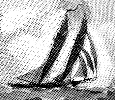 What is Circumnavigation What is Circumnavigation
 For
centuries the early explorers did not care how long they took to sail around the
world. Simply, they were glad to get home with crew large enough to handle their
ships. Usually it took couple of years to make their voyages, full of adventure
and danger and along with many stopping to plunder the lands and the natives
along the way and claiming the remains for king and queen were normal procedures
during that time. For
centuries the early explorers did not care how long they took to sail around the
world. Simply, they were glad to get home with crew large enough to handle their
ships. Usually it took couple of years to make their voyages, full of adventure
and danger and along with many stopping to plunder the lands and the natives
along the way and claiming the remains for king and queen were normal procedures
during that time.
The reason for the first voyages was to find a way to the Rich
East and to make profit, then to establish fortified bases in distant countries
to secure the trade. Colonization and exploitation became the rule – India for
cotton, Indonesia for spices, China for tea and china, and of course Australia,
first for disposal of criminals, rebels and anyone else who stood in the way of
the Establishment and then for grain and wool.
In 1800s British shippers discovered that financial gain could
be made through swift passages. First, they used American-built wooden fast
ships like James Baines and Lightning for Australian trade, then they started
building their own composite clippers like Cutty Shark and Thermopylae for the
China tea speedy transport.
With fast ships came speedy voyages. At their best, these ships could dash to Australia in nearly 60 days,
spent about a month off and on loading, then speed home in about 70 days, thereby going
around the world in almost 160 days. Unfortunately those fast clippers were replaced by
the larger grain-hauling barks like the Moshulu sailing well into the 1930s, until steam ships eventually replaced them.
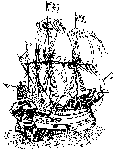 Since Magellan
and his crew proved that one could sail continuously in one direction until once again reaching
one’s homeport, circumnavigating the globe has been aspiration of countless sailors.
Probably the first yacht to circumnavigate was British schooner Nancy Dawson in
1850. Joshua Slocum finished the first solo circumnavigation in 1898. Then others followed their example of leisure cruising from one port or anchorage to
the next, until 1967-68 when Sir Francis Chichester sailed from Plymouth to Sydney and
back via Cape Horn for speed. Since Magellan
and his crew proved that one could sail continuously in one direction until once again reaching
one’s homeport, circumnavigating the globe has been aspiration of countless sailors.
Probably the first yacht to circumnavigate was British schooner Nancy Dawson in
1850. Joshua Slocum finished the first solo circumnavigation in 1898. Then others followed their example of leisure cruising from one port or anchorage to
the next, until 1967-68 when Sir Francis Chichester sailed from Plymouth to Sydney and
back via Cape Horn for speed.
Sir Francis Chichester did not beat the clippers’ time, but he set the time mark for
those who followed. Now the challenge became not simply to sail around the world, but to
be the fastest to do so. More sailors, either solo or with crew, set out for
circumnavigation and started to claim they were fastest. And here the trouble started.
As we know the speed is calculated as time over distance. During
circumnavigation the time is done by our calendar system but the distance could be very
different. Basically, to circle the globe means that you cross all 360 meridians of
longitude. 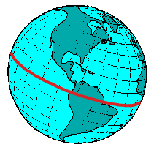 If everybody
would be able to do it on the equator, everything would be OK because everybody would have
to cover the same distance for the speed claim. The problem is that you can cross all 360
meridians close to the North or South Pole and you may claim that you have done
circumnavigation as well. If everybody
would be able to do it on the equator, everything would be OK because everybody would have
to cover the same distance for the speed claim. The problem is that you can cross all 360
meridians close to the North or South Pole and you may claim that you have done
circumnavigation as well.
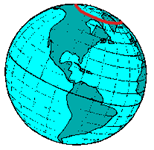 If
you do it a few feet off the pole, you can be very fast too, but would it be fair to claim
it as a circumnavigation? If
you do it a few feet off the pole, you can be very fast too, but would it be fair to claim
it as a circumnavigation?
So how to set fair rules for specification of circumnavigation,
especially when everybody can start the voyage in a different corner of the world? The
answer is very simple: you must at least follow a great circle. But what is a great
circle?
A great circle is a line traced on the surface of the globe by a plane
cutting through the sphere at its center. It is a largest circle, which can be drawn on
the surface of globe.
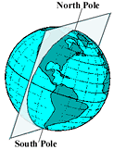 All longitudes
are great circles because the plane cutting through every meridian of longitude cuts
through the center of globe as well as through North and South Pole. Unfortunately there
is no way to sail just following meridians. All longitudes
are great circles because the plane cutting through every meridian of longitude cuts
through the center of globe as well as through North and South Pole. Unfortunately there
is no way to sail just following meridians.
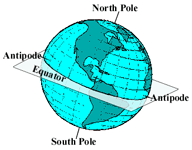 If you put plane
through the latitudes, only plane going through equator crosses the center of the globe
and therefore only equator is a great circle. But again, you cannot sail following the
equator, because the continents. If you put plane
through the latitudes, only plane going through equator crosses the center of the globe
and therefore only equator is a great circle. But again, you cannot sail following the
equator, because the continents.
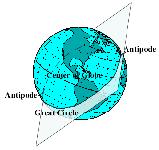 The
simplest way to prove that one followed the great circle is to put the plane through any
point of one’s sailing, preferably through the start point, and through the center of
the globe, and then to find the opposite point on that plane – the point called
antipode. Simply put, if somebody’s journey crosses pair of antipodes, he sailed a
great circle (most probably even more due to passing around the continents), and he can
claim true circumnavigation. The
simplest way to prove that one followed the great circle is to put the plane through any
point of one’s sailing, preferably through the start point, and through the center of
the globe, and then to find the opposite point on that plane – the point called
antipode. Simply put, if somebody’s journey crosses pair of antipodes, he sailed a
great circle (most probably even more due to passing around the continents), and he can
claim true circumnavigation.
If a trip did not cross a pair of antipodes, the sailing did
not follow the great circle. It does not matter how much shorter voyage was,
even if the passage was longer that the one done just around the pole, the claim
for record has no merit and is doubtful.
Looking back into history, we can find that when in 1522
Magellan and del Cano did first circumnavigation on 90 feet long Victoria, they
circled 2 pairs of antipodes. Magellan died during the voyage, but he
visited Indonesia earlier, sailing around Cape of Good Hope and he circled the
world. Circumnavigators from various countries who followed well into 1820 like
Drake (four par of antipodes), Cavendish, Dampier, Cowley, Anson, Wallis, De Bougainville, Cook, Krusenstern and others followed antipode tracks.
Early mentioned ships like James Baines, Cutty Shark, Moshulu
and others passed 2 pairs of antipodes. Joshua Slocum even crossed five pairs. Chichester, who studied track of old sailing ships and theirs claims for speed
records, clearly set formula for circumnavigation in writing in his book as
track with two points on the earth's surface diametrically opposite each other.
In 1967, when he finished his solo circumnavigation for speed, he also claimed
"true" circumnavigation as result of it.
After Chichester's circumnavigation with one stop, only
nonstop circumnavigation was left to be done and in 1968 The Sunday Times
newspaper announced Golden Globe trophy for first fastest nonstop solo
circumnavigation. They set start and finish in the same port located north of 40
degree North and passing south of Cape of Good Hope, Cape Horn and Cape Leeuwin.
Editors did not expected anybody sailing south of 40 degree South, except
passing Cape Horn, and thus automatically follow the antipode rules. Robin
Knox-Johnson was only one to finish the race in 312 days, however Bernard
Moitessier did not finish the race, but he circled globe 1 1/2 times finishing
in Tahiti and closing the loop first, he become first solo nonstop
circumnavigator.
Few years later, in 1971, the founding editor of the Guinness
Book of Records Norris McWhirter published Chichester's precedent as a rule
which prevented shortcuts from being taken. For
over 20 years, since 1970s to early 1990s this or a similar
antipode requirement was so posted in the marine records tables of the Guinness
Book of Records by Nobby Clarke who was solo circumnavigation historian and Guinness Book
marine records consultant. Later with help of Richard Boehmer, who specialized
in multihulls and continued in cooperation with Guinness Book for some time
after Nobby Clarke retired in 1990 from this activity.
The antipode rule was respectfully followed since:
Sir Francis Chichester's Gypsy Moth IV (1967)
- two pairs of antipodes along the route
Sir Robin Knox-Johnston's Suhaili (1969) - two pairs of antipodes along the
route
Chay Blyth's British Steel (1971) - two pairs of antipodes along the route
Alain Colas' Manureva (1974) - two pair of antipodes along the route
Dame Naomi James' Express Crusader (1978) - two pairs of antipodes along the
route
Philippe Monnet's Kriter Brute de Brute (1987) - two pairs of antipodes along
the route
Olivier de Kersauson's Un Autre Regard (1989) - two pairs of antipodes along the
route
Over 100 finishers of the Whitbread (now Volvo) Round the World Races
and many more solo circumnavigators
Unfortunately the antipode rule appeared for the last time in
the 1993 edition of the Guinness Book of Records and then disappeared with a new
editor, of course soon the record claiming mess surfaced.
The British Royal Yacht Association solely
oversaw the 500 meter straight line sailing speed trials until 1972 and then
they created a special Committee. In 1988 this committee declared themselves as
World Sailing Speed Record Council (WSSRC) and expanded their "authority" to
offshore sailing speed records. The WSSRC of course soon made their own rules,
ignoring over 500 years old practice of antipodes, which even American submarine
"Triton" observed during 1959/60 submerged world circumnavigation. By the new
1992 rules vessel must start and finish from the same point, must cross all
meridians of longitude and must cross the Equator and the orthodromic track must
be at leas 21,600 miles (calculated on a great circle of "perfect sphere"). You
can see, that most new claims are only shortly longer. The old guys have no
chance to survive. They also moved the barrier between small and big boats from
50ft to 60ft. No more antipodes are required but instead 1,200 British pounds
fee is mandatory (I fill sorry for sailors from poor countries).
Also, by the paragraph 18 of their Rules "an individual
record will be erased when a race record is subsequently faster". Well, the
Council was never interested in history anyway. They do not keep track on old
records, they do not know who really did what. They can only confirm your speed
record on the base of their rules and their new data so long you fell in their
category. How good they are? Looking at their website (July 2005) on table of
Other Kinds of Sailing Records, one can see listed Joshua Slocum as a first solo
circumnavigation who sailed from Boston to Boston. Everybody who read Slocum
book know, that he started from Boston and finished in Newport, later moved to
Fairhaven. Did they listed Boston to Boston just to match their own requirement?
Well, if you have 1,200£ to spare, you can claim your record,
but you cannot be sure that somebody did not do it before or after you and
simply was not able pay the fee as old sea captains and old solocircumavigators
could not do it. So, what now?
Who knows where the "Council" is going to be 10 or 50 years
from now. All may turn back aligning with history. My suggestion would be to
follow the established tradition with antipodes. It would be much harder to
calculate and select some "short cut" truck just for claiming the record. Who
needs that?
Even the "history approach" is not straightforward and clear.
For example take first solo circumnavigator Joshua Slocum. He himself claims to
circumnavigate globe since April 24 1895 until June 27, 1898. The
circumnavigation is definitively closed loop. Slocum solo departure is from
Boston and finished in Newport. So, he did not closed loop, at least it s not
clear. Can we claim him as the first solo circumnavigator?
Slocum wrote that he sailed his trial-trip with his friend
Captain Pierce, but how he sailed from Fairhaven to Boston and when? They may
sailed together, what is very probable. Slocum was fishing unsuccessfully from
Boston for whole season. It was probably then, when he start sailing Spray
single-handedly. He spent also whole winter in Boston and led by the end of
April, so we may add almost whole year to his circumnavigation time. He wrote
that on July 3 he sailed (was he alone?) to Fairhaven, where hi de facto closed
the loop.
Strict rule-followers may disregard claim that Slocum was
first solo circumnavigator. Despite his questionable sailing from Fairhaven to
Boston, he later set second solo voyage from Fairhaven to Europe, during which
he was lost. During that trip he must definitively cross his first track from
the Boston, so he definitively closed the loop. There were rumors that he took
some passengers in West Indies. Slocum was a man who did not let go any
opportunity to make money. We will probably never know if the rumors are true.
We certainly can guess, that any such trip would not lower quality of his
solo circumnavigation. for Slocum she passengers would be nothing more than any
other cargo. He was the first, who set the standard and any small derivation
from today's practice should be accepted by my opinion.
Slocum was born in Nova Scotia - Canada. Solo
circumnavigation is set by nationality of the sailor and not by vessel's flag
registration. Was he Canadian or American? In his case we know, that his parents
were American on English side during American revolution. His father was a
Quaker, opposing war. After the War of Independence, like in Russian or other
revolution, the winners exiled thousands of people who could not take sides or
find themselves on wrong side and confiscated their property. In this case
Slocum family left for Canada. Much later Joshua Slocum made his home in San
Francisco, where he became American citizen long before his solo voyages. But
this may not be so clear in many other cases.
Argentinean Vito Dumas was a first solo circumnavigator to
sail in "roaring forties" south of all capes, something not imaginable to do by
small boat at that time. He never passed antipodes but everybody accepted his
circumnavigation simply because he was first and he done something what nobody
else did before him.
Well, some sailors lost their boats and before they finished
their trip, some of them sailed three various yachts. How to judge the "yo-yo"
circumnavigation done by Adrian Hayter in 1950/60. What the "Council" will do?
First he sailed from Great Britain to New Zealand via Suez on 32' long Sheila II
and then he sailed 25' long Valkyr again from Great Britain to New Zealand, but
this time opposite way through Panama, he closed the loop.
To solo circumnavigate in trade wind region through canals
and passing the antipodes is much easier to do than sailing around in "roaring
forties" and passing Cape Horn. If one starts such circumnavigation from Europe,
most probably he would pass antipodes, but what about sailors from BOC who
set sails from Newport. Is their sailing less demanding and less valuable
because they did not pass antipodes? I can tell you no, despite being only one
sailor who passed antipode during all BOC races - it was accident anyway because
I had to stop at Fremantle for repair after heavy knock down. And what about
Vendee Globe sailors? How to reasonably compromise and make balance?
It seems to me that solo circumnavigation should be divided
in categories as normal sailing is divided anyway (who can count all those
classes?). By my opinion (that what you can find on my website) all sailors who
sail around the world alone, passed all meridians and their track is longer than
the Equator could claim that they did solo circumnavigation and therefore they
are listed on my website by the date of their finishing. The listing deserve
also solo sailors who rescued anybody as long as extended crew did not help them
to handle the boat for the rest of the passage. It would be not fair to
disqualified anybody efforts just for providing help.
Definitively anybody, who wants to claim any record should
pass antipode test - no exception!
Anybody, who passed antipodes deserves to be recognized as
"True Circumnavigator". Also I think that sailors who passed all five
southernmost capes deserve it's own recognition, especially those who did it the
"wrong" way, the same as first sailors from each country. The solo around the
world sailing races are separate categories and its sailors deserve to be listed
as circumnavigators as well. I think that nobody has any objection to
differentiate women and men and monohulls and multihulls.
Following website pages contain data which were collected
during few decades. I am aware that there could be many misinformation and I
encourage everybody to send me any available correction. I would like to link
every sailor to it's separate page with description of voyage, map, some
pictures, audio or video as well. This pages are created in little of personal
free time and any your help will be highly appreciated. Thank you.
Richard Konkolski
Return to Solo Sailing
Solo Sailing
Copyright
Creators of this site put a lot of effort and a lot of their time in gathering all
presented information. If you want to use any of published facts for your private or
commercial project, please contact us first. We will be willing to let you use our data
for a fee, which only will help us to make this web better. We discourage copying our
information directly from this web without our knowledge. It may be destructive to you
project, because many presented information are unique and many has small blunders which
would link unauthorized copier to our source. Thank you for respecting the Copyright.
Copyright Richard Konkolski
Back to Solo Sailing

|